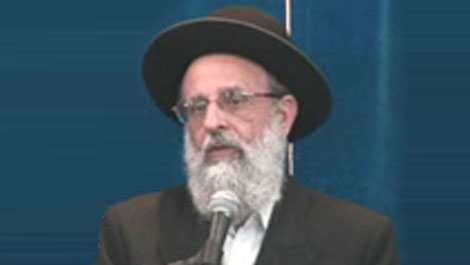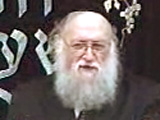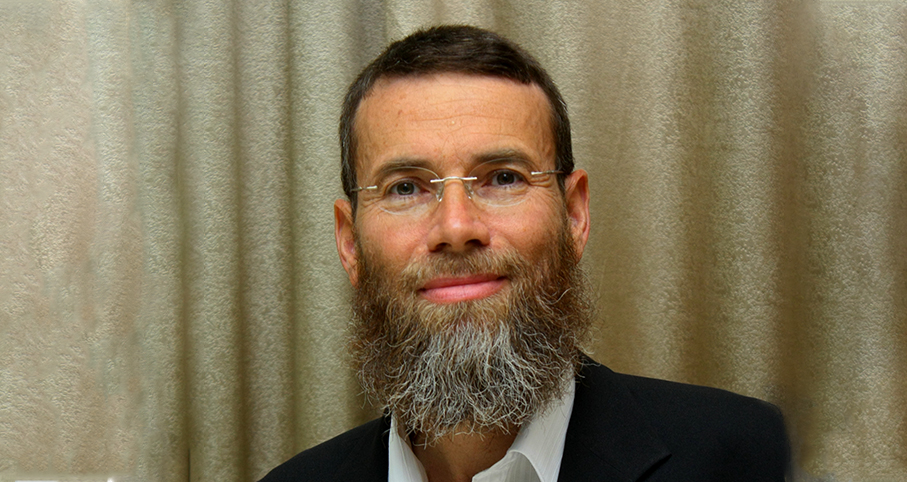Beit Midrash
- Torah Portion and Tanach
- Bereshit
- Vayera
Quiz Question #1:
Mrs. Yunger gave birth to two healthy twin boys, each of whom had his bris on the first day that halacha mandates, yet the younger Yunger had his bris several days earlier than his older brother. How can this happen?
Question #2:
Moshe Litvak asks me: "I have often wondered why my chassidishe brother-in-law davens mincha after sunset, when the Mishnah Berurah rules that one should not daven this late!"
Question #3:
"My sister and I live in the same yishuv (community), and the nearest hospital is Laniado, in Netanya. She went into labor on Shabbos and left for the hospital. Immediately after Shabbos, I phoned the hospital to find out how she was and whether she had a boy or a girl, and was told by the gentile receptionist that she could not put the call through to my sister until after the time 'Rabbeinu Tam' arrives, which would not be for another half an hour. Why was the gentile receptionist so frum?"
Why Did the Younger Yunger have an Earlier Bris?
Although a bris that transpires on the eighth day of a child's life supersedes Shabbos, when a baby is born during bein hashemashos, a halachic "twilight zone" in which it is uncertain whether it is part of the previous day or the next one, his bris cannot be conducted on Shabbos. The older Yunger was born during bein hashemashos on Friday evening. Thus, his bris could not be performed on either Friday or Shabbos, and his bris was postponed to Sunday. Moreover, if one or two days of Yom Tov immediately followed Shabbos, then his bris would be delayed until after Yom Tov. However, his younger brother was born at a time that was certainly Shabbos, and therefore, his bris took place on Shabbos. Thus, younger Yunger had his bris before older Yunger.
When is Twilight?
When is bein hashemashos?
We all are aware that the Jewish date begins at night. But at what exact moment does one day end and another begin? Do we know the precise instant when one day marches off into history, and its successor arrives with its banner unfurled?
A verse in the book of Nechemiah might help resolve this question. There it describes the unenviable circumstances in which the Jews were rebuilding the Second Beis Hamikdash, while protecting themselves from the enemies who were determined to thwart its erection: And we were continuing the construction work from daybreak until the stars come out [tzeis hakochavim] while half our men were holding spears… and at night we were on guard, while in the day we could proceed with the work (Nechemiah 4:15-16). Nechemiah implies that "night" begins when the stars emerge, and the time of dusk until they become visible is still considered the previous day (see Berachos 2b; Megillah 20b).
However, we still require more definition. Which stars? Can we pinpoint the moment that the stars come out, since the stars of the firmament do not all become visible at the same time?
Additional confusion is caused by a different verse that implies that the day ends when the sun sets, as the Torah (Vayikra 22:7) proclaims: And when the sun sets, he shall become pure, stating that the final stage of purification from some types of tumah is the sunset after immersion in a mikveh. However, at sunset no stars are yet visible. Thus, this verse implies that the changing of the day transpires at sunset, not when the stars appear (see Berachos 2b).
What a Phenomenal Dusk!
Is there any discussion in the Gemara that can "shed light" on our question? Indeed, there are several passages, and much literature is devoted to understanding them. One passage (Shabbos 34b) describes certain celestial phenomena that define when bein hashemashos begins and when it ends. The commentaries debate exactly what occurrences are being described, and, unfortunately, we derive little usable information from this passage.
When Three Stars Appear
Another passage indicates that the end of the day is determined by the appearance of stars. When one star appears, it is still day. When two appear, it is bein hashemashos, and when three appear, it is night. Not large stars that appear even in the day, and not small stars that first appear at night, but middle-sized stars (Shabbos 35b).
Now the job appears easy. Let us look at the darkening firmament this coming evening and count stars!
I am sure that there have been times when you have tried. Ever spent Shabbos on a camping trip and attempted to determine the end of Shabbos by stargazing? How did you decide which stars are considered "small," "large" and "middle-sized"? And this is assuming that one does not need to deal with light pollution!
Perhaps, locating a Gemara discussion that indicates more objective criteria, such as units of time, may be more helpful in our search to determine the end of day. Does such a discussion exist in the Gemara?
Yes, it does -- and not only one passage, but two. However, the two passages appear contradictory!
Conflicting Gemara passages
The Gemara in Pesachim (94a) states that the time between shekiyah, a word usually translated as sunset, and tzeis hakochavim equals four mil, which we will assume is 72 minutes. (This concurs with the more obvious way of explaining the opinion of the Terumas Hadeshen [#123] and the Shulchan Aruch [Orach Chayim 459:2; Yoreh Deah 69:6 with Shach] that a mil used as a unit of time equals 18 minutes.) However, a different passage of Gemara, in Mesechta Shabbos (34b), quotes a dispute in which Rabbah states that nightfall occurs three-quarters of a mil, or 13½ minutes, after shekiyah, and Rabbi Yosef rules that it transpires a bit earlier, two-thirds of a mil, or 12 minutes, after shekiyah. Obviously, we need to explain why one Gemara states that nightfall occurs 72 minutes after shekiyah, and another states that it occurs only 12 or 13½ minutes after shekiyah!
Rabbeinu Tam's explanation
Among the many resolutions to this conundrum, the two most commonly quoted are those of Rabbeinu Tam and the Gr"a. Rabbeinu Tam contends that these two passages of Gemara are using the word "shekiyah" to refer to two different phenomena which occur about an hour apart. The Gemara in Pesachim uses the term shekiyah to mean sunset -- when the sun vanishes beyond the western horizon. Rabbeinu Tam refers to sunset as techilas shekiyah, literally the beginning of shekiyah. However, when the Gemara in Shabbos refers to "shekiyah," it does not mean sunset, but a point in time about an hour later when virtually all light of the sun's rays is dissipated from earth. Rabbeinu Tam refers to this later time as sof shekiyah, literally the end of shekiyah, and, in his opinion, until sof shekiyah occurs it is still halachically day, notwithstanding the setting of the sun and the appearance of hundreds of stars in the firmament. All these stars are considered "large stars" whose appearance does not demonstrate that the day has ended. Only at sof shekiyah does it become bein hashemashos, the time when we are uncertain whether it is day or night. At sof shekiyah, bein hashemashos has begun, meaning that now two, but not three, "middle-sized" stars are visible, and we await the appearance of the third "middle-sized" star to know that it is definitely night. (However, cf. Minchas Kohen for a variant understanding of Rabbeinu Tam's position.)
Since, according to Rabbeinu Tam, it is definitely still day until about an hour after sunset, many authorities contend that there is no problem with davening mincha considerably after sunset. (However, note that Rabbeinu Yonah understands the opinion of Rabbeinu Tam differently from what I just explained.) Thus, there are communities who base themselves on this approach and daven mincha well after sunset.
Rabbeinu Tam and a friday night birth
According to Rabbeinu Tam, a baby born 58 minutes after sunset on Friday evening, and certainly any time earlier, was born halachically on Friday, and not on Shabbos. In Rabbeinu Tam's opinion, this baby's bris takes place the following Friday. A baby making his appearance a bit later is considered to be born during bein hashemashos and cannot have his bris on Shabbos, because maybe bein hashemashos is still Friday -- which makes Shabbos his ninth day of life. This bris will be postponed to Sunday. However, if he is born later on Friday evening, at a time when it is definitely Shabbos, then the bris is performed on Shabbos.
It goes without saying that, according to Rabbeinu Tam, one may not perform any melacha on Saturday night until a considerable time has passed after sunset. There are various opinions as to exactly when Shabbos is definitely over according to Rabbeinu Tam, but most people assume that Shabbos is over by 72 minutes after sunset (Biur Halacha).
By the way, at this point we can answer our third question above: why the telephone lines at Laniado hospital are not open to non-pikuach nefesh related calls until more than a half hour later than the time Shabbos ends according to most calendars. The founder of the hospital, the Klausenberger Rebbe, insisted that Shabbos be observed at the hospital until it is over according to Rabbeinu Tam.
The opinion of the Gr"a
Since we know that many highly observant Jews do not wait this long for Shabbos to end, there must be another way of interpreting the two passages of Gemara that reaches a different halachic conclusion. Indeed, one such approach is presented by the Gr"a, who who has a completely different way of explaining why the Gemara in Pesachim states that tzeis hakochavim does not occur until 72 minutes after sunset, whereas the Gemara in Shabbos has tzeis hakochavim occurring much earlier. The Gr"a contends that both passages use shekiyah to mean sunset, and this is the same sunset to which we customarily refer -- however, they are not referring to the same tzeis hakochavim. The Gemara passage in Pesachim that refers to tzeis hakochavim being 72 minutes after sunset means that all visible stars of the firmament can now be seen, a time that the Gr"a calls tzeis kol hakochavim, literally, when all the stars have appeared, whereas the Gemara in Shabbos refers to the time at which three "middle-sized" stars are visible. The Gr"a concludes that sunset begins the time of bein hashemashos, the time when we are uncertain whether it is day or night, with tzeis hakochavim occurring when three "middle-sized" stars are visible. The Gemara in Pesachim that requires 72 minutes until the stars appear is not discussing when the day ends -- the day ended much earlier -- but is concerned about when all remnants of sunlight vanish.
According to the Gr"a's opinion, once sunset arrives on Friday, it may already be Shabbos. We consider this time to be already bein hashemashos, and we therefore refrain from performing any melacha from this time. In the Gr"a's opinion, a baby born after sunset Friday will have his bris performed on Sunday a week later, unless he is born after three "middle-sized" stars appear, in which case his bris will be performed on Shabbos. (In practice, since we are uncertain exactly which stars are called "middle-sized," we wait a bit longer, see Biur Halacha to 393.) According to Rabbeinu Tam, this same baby would have his bris performed on Friday, unless he is born at least 58 1/2 minutes after sunset. If he is born between 58½ minutes and 72 minutes after sunset Friday evening, according to the Gr"a, his bris will be on Shabbos, whereas according to Rabbeinu Tam -his bris will be on Sunday. Rabbeinu Tam agrees that a baby born later on Friday evening will have his bris performed on Shabbos.
The Gr"a rules that one should not daven mincha after sunset, since this is already a time at which the previous day may have already passed. Thus, it is already time to daven maariv.
How do we rule?
Although in the past there were Torah communities that did not follow the Gr"a at all, even regarding the onset of Shabbos, today, it is universally accepted to consider it Shabbos from sunset on Friday. Many communities follow the Gr"a's opinion fully, and do not wait until 72 minutes after sunset on Saturday to end Shabbos. In a responsum on the subject, Rav Moshe Feinstein took great umbrage at those in Eretz Yisroel who wait only 25 minutes after sunset to end Shabbos, contending that since a large number of Rishonim followed Rabbeinu Tam's approach, one should act stringently and not end Shabbos until at least fifty minutes after sunset, which he felt fulfills "Rabbeinu Tam time" according to the basic halachic requirement (Igros Moshe, Yoreh Deah 4:17:26; and Orach Chayim 4:62).
This Shiur is published also at Rabbi Kaganof's site
Birth and Sacrifice
Akeidat Yitzhak and the Story of the Jewish nation
Rabbi Berel Wein zt"l

LEAVING THE COMFORT ZONE
Rabbi Stewart Weiss | Cheshvan 18 5784























